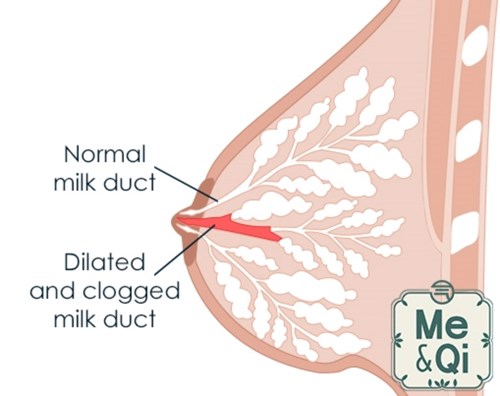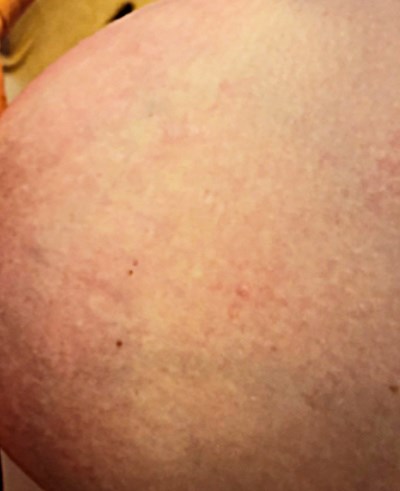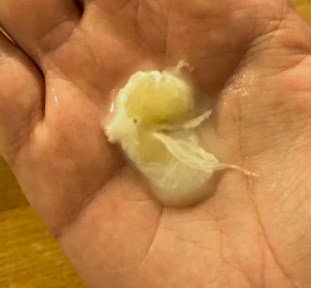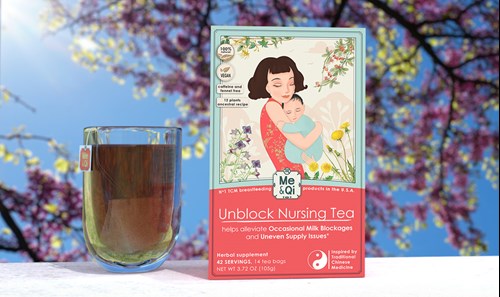Contents
- What Is A Clogged Milk Duct?
- What are the Symptoms of a Clogged Milk Duct?
- What Does A Clogged Milk Duct Look Like?
- What Does A Clogged Milk Duct Feel Like?
- Mastitis VS Clogged Duct Symptoms
- What Are The Early Signs of Clogged Milk Ducts?
- What Are The Causes Of Clogged Milk Ducts?
- How To Prevent Recurrent Clogged Ducts?
- How To Get Rid Of Clogged Milk Ducts?

What Is A Clogged Milk Duct?
A clogged milk duct is a condition in which a breast milk duct becomes blocked during or after breastfeeding, preventing milk from flowing to the nipple. The milk ducts are called mammary ducts, which are a complicated system of small tubes that carry milk from lobules, a gland inside the breast, to the nipple.
Each nipple has between 15 and 25 tiny holes called pores, but only 6 or 7 of them stay open during nursing or pumping.
Milk can get stuck in the duct if something squeezes it, like thickened breast milk or inflammation in the soft tissues and blood vessels nearby. Thickened milk is the most likely cause of clogged milk ducts.
What are the Symptoms of a Clogged Milk Duct?
What Does A Clogged Milk Duct Look Like?
- Red Skin
Red skin is quite common with clogged milk ducts, due to an inflammatory process going on under the breasts, which is also called 'Toxic Heat’ according to Chinese Medicine. It could also be due to breast infections such as mastitis.

- Swollen and Engorged Breasts
Like red skin, breasts can also appear swollen due to inflammation. It may get engorged as well when trapped breast milk accumulates inside ducts. The situation can be partially relieved if some milk is released.
- Thickened or Half Solid Breast Milk
If a nursing mother consumes excessive amounts of heavy and oily foods over a long period, her breast milk is more likely to become thick or somewhat solid due to the rich fat content in the diet. This increases the risk of clogging milk ducts.
- Hard Lumps or Small Nodules
Hard lumps often develop in breasts or under armpits, they can be as big as covering more than half of the breast or as tiny as a small pea. While small nodules can appear in the areola as well, in addition to breasts and armpits. They develop due to the deposition of milk in the milk ducts.
- Nipple Blisters or Blebs
A milk bleb or blister is a blocked nipple pore caused by various factors, such as the solidification of breast milk, the formation of scabs on the nipple, or the collection of dry pus or blood. In addition, a thin layer of skin might grow over a nipple pore and block it as well.
- Unequal Milk Supply
An unequal milk supply between the two breasts is not unusual with clogged milk ducts. This symptom has been reported to us by numerous mothers.
Here are some specifics of a real case of an uneven milk supply. According to the mother, 90% of the entire milk supply came from one breast, while the other one only counts for 10%. In addition, her newborn refused to breastfeed from the affected breast. This problem had been going on for a few weeks.
Besides unequal milk supply, she did not experience any other symptoms or signs, such as a lump, red skin, or swelling. In this case, this unequal milk production strongly suggested that a part of the minor milk ducts were blocked, as if something prevented the milk from escaping.
For this case, Unblock Nursing Tea was recommended to this mother, and within a few day, her condition was partially relieved. The ratio between the two breast milk supplies shifted from 90% and 10% to 70% and 30%, providing more milk from the affected breast during breastfeeding.
What Does A Clogged Milk Duct Feel Like?
- Warm or Even Hot Breasts Skin
A clogged milk duct may feel warm or even hot to the touch due to the inflammation caused by milk accumulation. The hardened milk presses the duct tissues and the surrounding blood vessels, triggering inflammation.
On top of that, bacteria may grow in the trapped milk and makes the inflammation worse.
- Hard Lump or Nodules
Breast Lumps feel hard to touch, like something firm, solid, and fixed inside the breast with a clear edge.
Over time, this hard fixed lump may become softer and start to feel like a balloon half filled with oil. This is a worst-case scenario which means the lump has become an abscess. In this case, your doctor may suggest a small surgery to suck the abscess from the breast.
- Sharp and Shooting Pain in the Breasts
Sharp and shooting pain is very common with clogged milk ducts. When breast milk fails to flow properly, pressure builds up inside the duct, causing irritation to the surrounding tissues and nerves.
- Breast Heaviness and Oppression
This is a frequently occurring symptom with clogged milk ducts. The mother has a feeling of chest heavy, full, and oppressed, like something is stuck inside the breast and fails to come out of the nipple pore.
- Breast And Nipple Itching
As we know that breasts become full and heavy due to milk accumulation in the milk ducts. This extra weight causes tightening and stretching of the skin, which can lead to constant itching on the breasts.
Mastitis VS Clogged Duct Symptoms
Mastitis is an bacteria infection condition that occurs deep in the breast tissue.
A clogged milk duct is much less severe as it is simply a blockage due to infrequent emptying of milk. While mastitis often occurs when bacteria grows in the clogged area.
When a mother has mastitis, she often develops numerous clogged milk duct manifestations mentioned above. On top of that, there are also many symptoms and signs unique to mastitis. For example, she might feel like having a flu or a bad cold. We will list these typical mastitis signs and symptoms below:
- Fever higher than 101.3°F ( 38.5°C)
Fever is specific to mastitis. It occurs when the mother’s immune system fights the bacteria or virus that causes the infection. If she has a high temperature that continues for more than a day without getting better, this is an indication that the mastitis may have progressed.
There is also a possibility that an abscess may develop from the infected area. In this situation, we recommend contacting a doctor and taking treatments such as antibiotics.
- Headache, Chills, and Nausea
-
- Headache
With mastitis, you might feel a tight band-like sensation on your head, like something is pressing your head. It is the most frequently encountered symptom in infections like mastitis.
-
- Chills
Chills are often a sign that a fever is coming. It happens because muscles contract and relax quickly. It is the way the body warms itself when it feels cold.
-
- Nausea
Nausea is not a disease, but a stomachache that often comes before throwing up. Some mothers report nausea feeling when they have mastitis.
- Sticky discharge coming out of the nipple pore
Most of the time, it is normal to have a milky discharge when a nipple is squeezed. However, sticky yellow, brown, or green color discharge is not normal, as it indicates mastitis or a potentially dangerous complication such as an abscess. In case of an abscess, surgical drainage will be necessary.
What Are The Early Signs of Clogged Milk Ducts?
Having clogged milk ducts is a particularly stressful condition for the mother and the baby. Therefore, it is better to know its early signs, so as to prevent it at the initial stages rather than treat it later. Some of the most common initial signs include:
- Sudden Decrease in Milk Supply or Uneven Milk Supply
A sudden decrease in milk supply is an early sign of clogged milk ducts. Normally, a fluctuation within 20% in daily supply is quite common. The lost volume can easily be regained if additional pumping sessions are made.
However, if milk production suddenly reduces by about 30% or more, it may be due to a plugged milk duct. Sometimes, as much as half of the daily supply could be lost in a relatively short period. This sudden decrease can lead to an unequal milk supply which has been explained above.
- Breasts get engorged more frequently
The breasts get engorged more frequently because the breasts are always half full. This happens due to a number of reasons such as missing a feeding, improper latching, poor nursing positions and not giving enough time for the baby to feed.
- The breast starts to feel heavy, full, and oppressed
When there is a clogged milk duct, breasts start to feel heavy and appear full and oppressed due to the extra weight of the accumulated milk. As more milk is trapped inside the duct than being drained.
- The milk gets thicker and fatter than usual

Normally, most mothers observe thick and creamy milk at the end of a feeding, which is called 'hindmilk'. It is because the amount of fat/lipids in the milk steadily increases as the feeding continues. This is a normal situation. This fat content makes up only 4.4% of breast milk but provides 60% calories needed for the newborn.
However, if a nursing mother consumes excessive amounts of fatty foods such as pork, lamb, chicken, cheese, butter, chocolate, and ice cream, the fat content in her breast milk might exceed the normal level. As a result, her milk becomes thicker and fatter, and she is now more likely to have a milk duct blockage. This is because some fatty particles adhere to the duct and eventually block the nipple pore.
- Baby gets more aggressive on suckling
When the baby feeds from the affected breast, the slower milk flow may make him/her fussier and more aggressive as the infant must suckle harder to obtain more food. Additionally, a pumping machine may also have problems with properly emptying your breast. You may need to enable the high-grade settings to completely empty your breast.
What Are The Causes Of Clogged Milk Ducts?
A clogged milk duct happens mostly due to a sudden change in breastfeeding schedule and habits. For example, it can be skipping a feeding or pumping session, going too long between the feedings, or changing of latching position. When the mother's body doesn't respond well to this sudden change, clogged milk ducts appear.
On top of that, Traditional Chinese Medicine (TCM) has another theory on the cause of clogged milk ducts, which is the accumulation of Toxic Heat in the breast. Here, the term Toxic refers to bacteria, and Heat refers to inflammation.
Toxic Heat accumulates when a mother is under prolonged mental stress or consumes too many hot and fatty foods. It may also occur when bacteria enter the breast from the baby's mouth through a nipple fissure.
All of these causes may contribute to inflammation and infection, which eventually block the milk ducts. For a detailed list of causes and analyses, please read this great article.
How To Prevent Recurrent Clogged Ducts?
Some mothers are more likely to experience recurrent clogged milk ducts. Because of this, it's crucial to think about prevention strategies in addition to treatment options. The principle is to:
- Keep routine breastfeeding habits and schedule
- Avoid pressure or trauma on the breasts
- Clear Toxic Heat in the breast
- Be away from emotional stress and try to be in a good mood
For more details, please check this article on the detailed techniques you can use to prevent clogged milk ducts, especially if these symptoms and signs are for recurrent cases.
How To Get Rid Of Clogged Milk Ducts?
On the other hand, when you have already a clogged milk duct, you can follow certain treatment strategies and techniques to unclog a milk duct.
For example, massage the hard lump or use Haakaa while pumping or breastfeeding to speed up the milk flow. In terms of blisters or blebs, you can consider popping them out with a sterilized syringe or needle. To ease sharp and shooting pain, you can use frozen pads or cabbage on the breasts as a natural remedy. Or some medicines such as Ibuprofen or Tylenol are also considered safe while breastfeeding.
In the case of mastitis, you may have to take antibiotics to fight the bacteria responsible for causing the infection. To find out more details about unclogging a milk duct, check out this great article.

Finally, you can also try Unblock Nursing Tea, which is specifically created for nursing mothers. It not only works on the existing clogged milk ducts but also helps prevent recurrences. For treatment, you can use 3 teabags a day, while for prevention 1-2 teabags a day will make the difference.
It is a blend of natural cooling, warm and neutral herbs such as Licorice, Goji berry, Dandelion, and Honeysuckle flowers. These herbs work collectively on different causes of clogged milk ducts such as thickened milk, emotional stress, or accumulated Toxic Heat. It makes the milk less thick, breaks up the milk lumps, and relieves swelling or pains.

